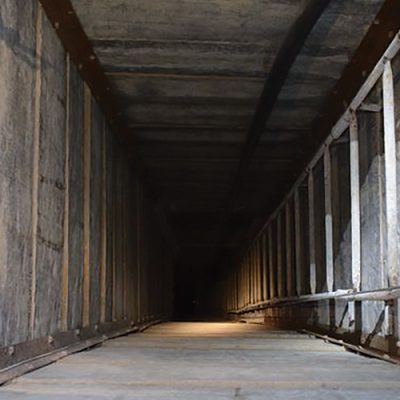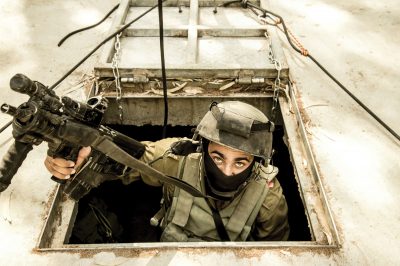
by: Joshua Spurlock, The Mideast Update
 A tunnel door creaks open in the dead of night in the middle of a forest in northern Israel. Six Hezbollah terrorists clothed in camouflage gear and armed with guns and knives emerge. Nothing but open land separates them from Israeli towns where they can kill and kidnap civilians. Simultaneously, four other tunnels open, one hidden inside the security fence of an Israeli military base. It’s a terrifying thought, but thankfully Israel at least partially prevented this potential nightmare in late 2018 by locating and destroying terror tunnels linking Lebanon with northern Israel.
A tunnel door creaks open in the dead of night in the middle of a forest in northern Israel. Six Hezbollah terrorists clothed in camouflage gear and armed with guns and knives emerge. Nothing but open land separates them from Israeli towns where they can kill and kidnap civilians. Simultaneously, four other tunnels open, one hidden inside the security fence of an Israeli military base. It’s a terrifying thought, but thankfully Israel at least partially prevented this potential nightmare in late 2018 by locating and destroying terror tunnels linking Lebanon with northern Israel.
Although this tunnel threat from the north felt new, it wasn’t. Israel has been battling tunnels for years. Hamas used a terror tunnel to kidnap Israel Defense Forces (IDF) soldier Gilad Shalit in 2006, and in 2014, Israel uncovered and destroyed dozens of terror tunnels in the south. Hezbollah even used “defensive” tunnels in the 2006 Second Lebanon War. Learning from those experiences has paid off, as Israel has neutralized over a dozen southern and multiple northern tunnels in the last few years.
But why did Hezbollah and Hamas decide to use the same terror tunnel weapon against Israel? And what does Israel’s recent success against the tunnels mean for the underground war on terror?
All the Above
According to former IDF spokesperson Lt. Col. (ret.) Peter Lerner, the main reason for Hamas and Hezbollah using the same approach is that it allows the terror organizations to achieve symbolic victory “with limited resources.” The image of a terrorist flag waving in Israeli territory sent around the world is an important goal.
“Everybody understands that they cannot strategically defeat the State of Israel…They need a symbolic victory, and how do they do symbolic victories? With focused images that send a clear message of, ‘We were able to defeat the mighty IDF,’” Lerner said in an interview with the Mideast Update. Such a feat, he noted, would boost the terror groups’ confidence. He also highlighted that tunnels are part of a strategic range of threats that include plans “at sea, underground, over ground, at the border itself,” as they are “refining their offensive activities.”
In an interview with the Mideast Update, Dr. Jonathan Spyer, an expert in Middle East affairs and director of the Rubin Center for Research in International Affairs at the Interdisciplinary Center (IDC) Herzliya in Israel, agreed that symbolism is important to the terror groups. However, it is “also psychological warfare in the sense that what they’ll be hoping for is that Israel will be seeking in the event of such a war to end hostilities quickly and on Hezbollah’s terms. And in that sense if they could capture Israeli civilians and then in the usual, rather ghoulish fashion which we know Hezbollah for, use them as kind of ‘human collateral’ for achieving political and military objectives, then I’m sure they’ll be very much looking to do that,” Spyer said.
Yet another reason both terror groups use the tunnels is that the threat of their previous preferred weapon of choice—rockets—has been significantly reduced by Israel’s missile defense system. Hence the “desire to develop another means of hitting at Israel…Whether or not they themselves are coordinating between the two [groups], that’s a common concern for them,” Spyer noted. Since Israel has started to have success against the tunnels too, this now raises questions regarding what will happen next.
All the Below
Spyer highlighted how good Israel’s intelligence has been in their role of finding the tunnels. While it’s “less surprising” to have intelligence on Hamas’s actions, given how Israel can surround the small Gaza Strip, Spyer said that “penetrating Hezbollah is another thing entirely. It represents, I think, an achievement on a much higher level, and I think that’s the way it’s being seen by all parties, including Hezbollah itself.”
Lerner explained the IDF has unveiled that its intelligence was aware of the Hezbollah plan to build tunnels for several years. The operational intelligence and combination with technology to detect the tunnels, he said, can put the terror groups “in situations where they need to be cautious…they have to keep in mind that there is probably a lot that Israel isn’t telling, and that Israel knows about. So they have to review everything that they are doing.”
Another blow to the terror groups is finances. Lerner noted that each of the roughly 15 Hamas tunnels destroyed in the last year was estimated to cost around US $3 million to build, saying it “absolutely” is a “financial setback” to Hamas. Up north, Spyer called it a “significant financial blow” to Hezbollah to lose the tunnels but said Iran has proven they’d rather fund Hezbollah terror—if Iran’s nuclear program is attacked, for example—even if the Iranian people need to “go without consumer goods.”
All the Time
 Despite Israel’s success, don’t expect the tunnel weapon to disappear, Lerner and Spyer agreed. “I think that when one says the tide has turned, I mean the tide in these kinds of contests don’t turn definitively,” Spyer said. “In other words, I think the way to look at it is that it’s a constant technological and intelligence race, in which at one time one side can have very considerable achievements, but that doesn’t mean that the other side’s out of the game. Right now in a certain sense, the ball is in Hezbollah and Hamas’s court.”
Despite Israel’s success, don’t expect the tunnel weapon to disappear, Lerner and Spyer agreed. “I think that when one says the tide has turned, I mean the tide in these kinds of contests don’t turn definitively,” Spyer said. “In other words, I think the way to look at it is that it’s a constant technological and intelligence race, in which at one time one side can have very considerable achievements, but that doesn’t mean that the other side’s out of the game. Right now in a certain sense, the ball is in Hezbollah and Hamas’s court.”
Lerner noted that the terror methods are ever evolving: explosive devices became suicide bombers, mortars turned to rockets and even the tunnels went from detonating beneath IDF soldiers to terror tunnels. “There’s this constant game of chess that is being played with these terrorist organizations, and we have to realize that there is always going to be something that they will try [to] take advantage of,” the former IDF spokesperson said.
“…When you feel that you’ve defeated suicide bombers or you’ve seen a reality where you are able to shoot down rockets out of the sky before they cause any damage, or when you see the ability to disconnect the tunnels as they’re coming along, then the question will be what is going to come next.”
All logos and trademarks in this site are property of their respective owner. All other materials are property of Bridges for Peace. Copyright © 2025.
Website Site Design by J-Town Internet Services Ltd. - Based in Jerusalem and Serving the World.